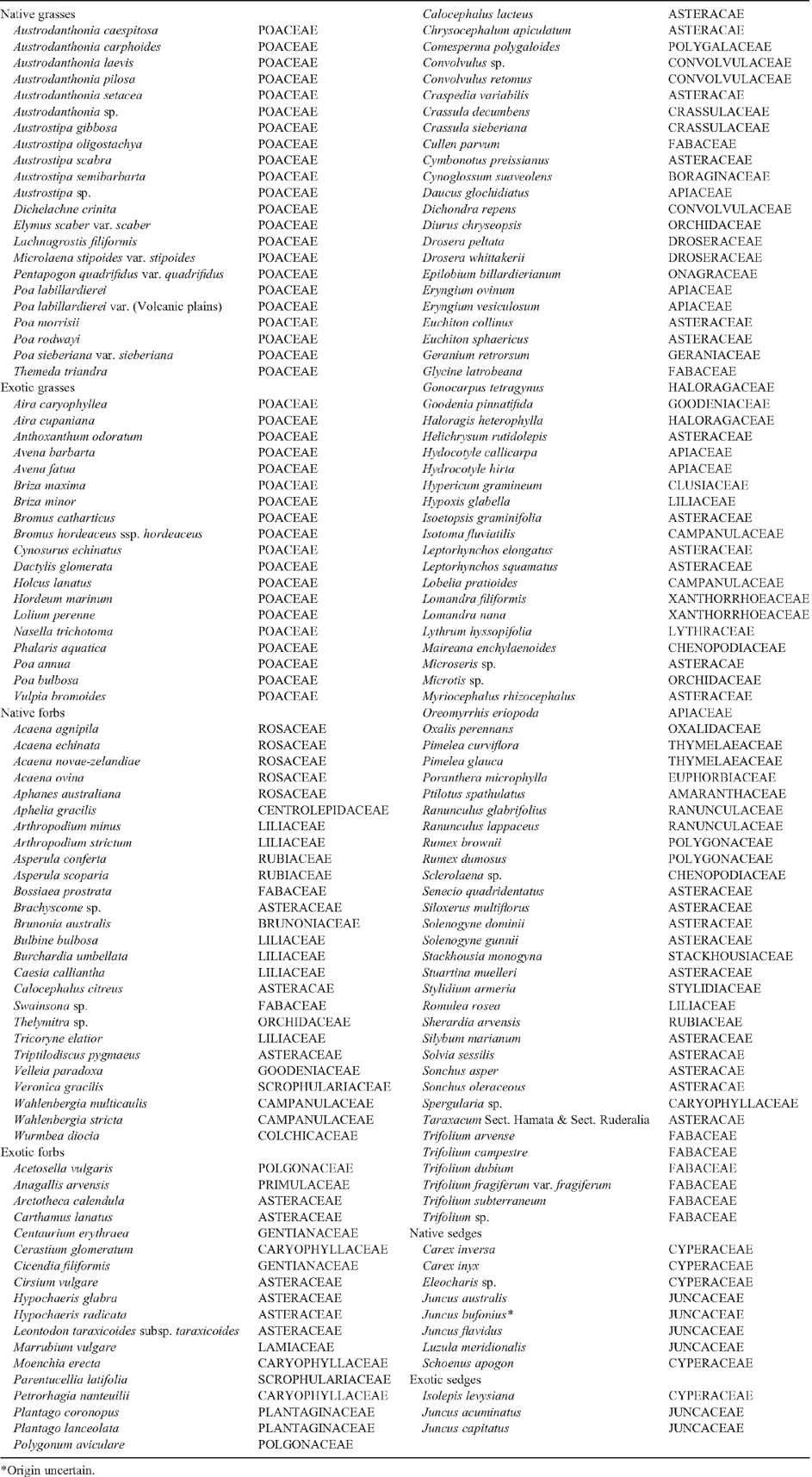Native grasslands in the PlainsTender incentive scheme: conservation value, management and monitoring
Heidi C. Zimmer A B , Jaimie Mavromihalis A , Vivienne B. Turner A , Claire Moxham A and Canran Liu AA Arthur Rylah Institute for Environmental Research, Department of Sustainability and Environment, PO Box 137, Heidelberg, Vic. 3084, Australia.
B Corresponding author. Email: Heidi.Zimmer@dse.vic.gov.au
The Rangeland Journal 32(2) 205-214 https://doi.org/10.1071/RJ09073
Submitted: 5 November 2009 Accepted: 13 April 2010 Published: 30 June 2010
Abstract
The native grassland of the Victorian Volcanic Plain, in south-western Victoria, Australia, is a critically endangered community. Much of the remaining grassland exists on private land, where it is grazed by livestock. The impacts of two grazing management strategies, implemented under the PlainsTender incentive scheme, were monitored at 18 on-farm native grassland sites for 4 years. The management strategies were (1) excluding grazing during spring, or (2) flexible grazing and resting. Maintenance of >70% vegetation cover was required under both strategies. Generalised least-squares (repeated-measures) modelling revealed a significant correlation between plant functional group cover and management. However, this correlation was present at the outset of the study and was maintained for the duration of monitoring. Sites rested from livestock grazing in spring had higher native and exotic grass cover, while exotic forb cover was higher at sites where grazing was managed flexibly. Native and exotic grass cover varied significantly from year-to-year under both management strategies; we attribute this to variation in rainfall, particularly drought in the second year. A key outcome of this study was the recognition that high conservation value native grasslands, i.e. large (≥100 ha) and intact (≥36 native species), are being managed successfully on private land, using a range of conservative livestock grazing strategies.
Additional keywords: ecomarket, native pasture, secondary grassland, livestock grazing, spring rest, Victorian Volcanic Plain.
Acknowledgements
We thank the landholders of the VVP who allowed us to undertake our research on their properties, without them this study would not have been possible. We thank Chelsey Langley, Anne Buchan, Judy Downe and Arn Tolsma for assistance in the field and Geoff Sutter, Fiona Coates and David Cameron for assistance with plant identification. Charles Huxtable, Steve Sinclair, Anna Murphy, Anne Buchan and an anonymous reviewer provided valuable feedback on earlier drafts of this manuscript. This work was funded by the Victorian Volcanic Plains Ecosystem Stewardship Project (funded by the Australian Government, implemented by Corangamite Catchment Management Authority), the Victorian Government Department of Sustainability and Environment and the Federal Caring for our Country program.
Aarssen L. W.
(2001) On correlations and causations between productivity and species richness in vegetation: predictions from habitat attributes. Basic and Applied Ecology 2, 105–114.
| Crossref | GoogleScholarGoogle Scholar |
(accessed 18 March 2010).
Costin A. B.
(1980) Runoff and soil and nutrient losses from an improved pasture at Ginnindera, Southern Tablelands, New South Wales. Australian Journal of Agricultural Research 31, 533–546.
| Crossref | GoogleScholarGoogle Scholar |
(accessed 18 March 2010).
Dorrough J.,
Ash J. E., McIntyre S.
(2004b) Plant responses to livestock grazing frequency in an Australian temperate grassland. Ecography 27, 798–810.
| Crossref | GoogleScholarGoogle Scholar |
(accessed 27 June 2007).
Stevens M. H. H., Carson W. P.
(1999) Plant density determines species richness along an experimental fertility gradient. Ecology 80, 455–465.
| Crossref | GoogleScholarGoogle Scholar |

Stoneham G.,
Chaudri V.,
Ha A., Strappazzon L.
(2003) Auctions for conservation contracts: an empirical examination of Victoria’s BushTender trial. The Australian Journal of Agricultural and Resource Economics 47, 477–500.
| Crossref | GoogleScholarGoogle Scholar |

Stuwe J, Parsons R. F.
(1977)
Themeda australis grasslands on the Basalt Plains, Victoria: floristics and management effects. Australian Journal of Ecology 2, 467–476.
| Crossref | GoogleScholarGoogle Scholar |

Tilman D.
(1987) Secondary succession and the pattern of plant dominance along experimental nitrogen gradients. Ecological Monographs 57, 189–214.
| Crossref | GoogleScholarGoogle Scholar |

Trémont R. M., McIntyre S.
(1994) Natural grassy vegetation and native forbs in temperate Australia: structure, dynamics and life histories. Australian Journal of Botany 42, 641–658.
| Crossref | GoogleScholarGoogle Scholar |

Westoby M.,
Walker B., Noy-Mier I.
(1989) Opportunistic management for rangelands not at equilibrium. Journal of Range Management 42, 266–274.
| Crossref | GoogleScholarGoogle Scholar |

Whalley R. D. B.,
Friend D. A.,
Sanford P., Mitchell M. L.
(2005) Evaluation of native and introduced grasses for low input pastures in temperate Australia: rationale and scope. The Rangeland Journal 27, 1–9.
| Crossref | GoogleScholarGoogle Scholar |

Williams N. S. G.,
Morgan J. W.,
McDonnell M. J., McCarthy M. A.
(2005) Plant traits and local extinctions in natural grasslands along an urban–rural gradient. Journal of Ecology 93, 1203–1213.
| Crossref | GoogleScholarGoogle Scholar |

Zimmer H. C.,
Turner V. B.,
Mavromihalis J.,
Dorrough J., Moxham C.
(2010) Forb response to grazing and rest management in a critically endangered Australian native grassland ecosystem. The Rangeland Journal 32, 187–195.


|


